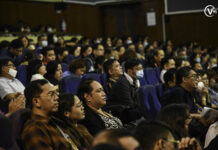INADEQUATE crisis management training may place the University at risk in the event of a bombing, an earthquake, or even a lone-wolf attack like that at the Resorts World Manila last June, campus emergency responders have bared.
Mark Lester Toribio, UST-AMV College of Accountancy incident commander, said there was a dire need to conduct regular trainings for all the people responsible for emergency response.
“If the University permits, we should conduct [the trainings] once a month because as we know there are so many incidents happening right now in the Philippines. It is unknown to everyone when these will strike,” Toribio told the Varsitarian.
Fredeswindo Medina, incident commander of the College of Tourism and Hospitality Management, admitted that the University still lacks disaster preparedness.
He said there should be more trainings and drills especially after recent earthquakes in the country.
The University conducts drills twice per semester. It also complies with city and region-wide drills such as the Metro Manila Shake Drill of the Metropolitan Manila Development Authority.
Arturo Patungan, incident commander of the College of Commerce and Business Administration, suggested that all faculty members be trained to aid in cases of emergency. There must be at least 10 members in a local crisis management team, he said.
“Ang kulang natin is culture of awareness. When we’re conducting a drill, we’re trying to inculcate the culture of being ready,” Patungan said.
An earthquake with Level 3 intensity was felt in the University last April 8. Following the quake, four people were rushed to the UST Health Service because of panic attacks.
Facilities lacking, quality check needed
Local incident commanders noted the lack of evacuation aids or materials in their assigned areas.
Patungan said Commerce, which occupies three floors of the St. Raymund de Peñafort building, does not have spinal boards that can be used to transport casualties. There are also not enough two-way radios, he said.
“Ideally there should be two spinal boards on both sides of every floor,” said Patungan, who is also the adviser of Commerce’s Red Cross unit.
Raymond Anselmo, Institute of Physical Education and Athletics incident commander, said classrooms in the Quadricentennial Pavilion do not have public address speakers that can be used to announce evacuation procedures.
Toribio said the UST-AMV building, which also houses the University’s multi-deck car park and several food establishments on the first two floors, is at risk of gas explosions.
“Fast-food establishments and restaurants all use gas to cook. I have to be true and say that it is very scary,” Toribio said. “Students should be removed from this building because it is not safe. The building’s purpose was concentrated in commercial [activities] and the safety of the college to occupy the building is at risk.”
Outsiders needed
Toribio said government personnel should be included in the University’s incident command system to obtain more insights in emergency response.
“Kailangan din [nating] humingi ng tulong sa labas kasi ‘yong field of expertise ng stakeholders such as the Metro Manila Development Authority, Bureau of Fire Protection, Red Cross Central are gravely needed for safety inside the campus,” he said.
Aside from insufficient disaster management trainings in dealing with fire and earthquakes, the University incident commanders also admitted to being unaware of protocols on bombing and shooting incidents.
UST Central Library incident commander Estrella Majuelo said trainings on such incidents were “not enough” for personnel and faculty members to undertake safety measures.
Majuelo, who is also the chief librarian, said trainings were needed to help the crisis management personnel understand their functions.



















